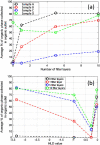A Coalescing Filter for Liquid-Liquid Separation and Multistage Extraction in Continuous-Flow Chemistry
- PMID: 38783854
- PMCID: PMC11110050
- DOI: 10.1021/acs.oprd.4c00012
A Coalescing Filter for Liquid-Liquid Separation and Multistage Extraction in Continuous-Flow Chemistry
Abstract
Presented here is the design and performance of a coalescing liquid-liquid filter, based on low-cost and readily available meltblown nonwoven substrates for separation of immiscible phases. The performance of the coalescer was determined across three broad classes of fluid mixtures: (i) immiscible organic/aqueous systems, (ii) a surfactant laden organic/aqueous system with modification of the type of emulsion and interfacial surface tension through the addition of sodium chloride, and (iii) a water-acetone/toluene system. The first two classes demonstrated good performance of the equipment in effecting separation, including the separation of a complex emulsion system for which a membrane separator, operating through transport of a preferentially wetting fluid through the membrane, failed entirely. The third system was used to demonstrate the performance of the separator within a multistage liquid-liquid counterflow extraction system. The performance, robust nature, and scalability of coalescing filters should mean that this approach is routinely considered for liquid-liquid separations and extractions within the fine chemical and pharmaceutical industry.
© 2024 The Authors. Published by American Chemical Society.
Conflict of interest statement
The authors declare no competing financial interest.
Figures








References
-
- Webb D.; Jamison T. F. Continuous flow multi-step organic synthesis. Chemical Science 2010, 1 (6), 675–680. 10.1039/c0sc00381f. - DOI
-
- Bennett J. A.; Campbell Z. S.; Abolhasani M. Role of continuous flow processes in green manufacturing of pharmaceuticals and specialty chemicals. Current Opinion in Chemical Engineering 2019, 26, 9–19. 10.1016/j.coche.2019.07.007. - DOI
LinkOut - more resources
Full Text Sources
